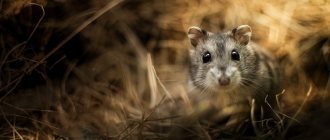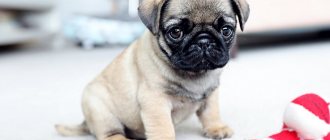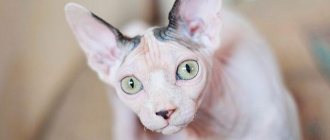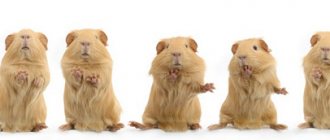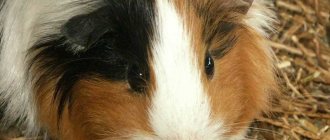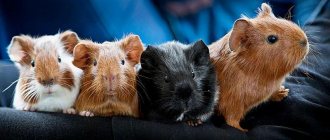How long guinea pigs live at home is of interest to every owner of a small pet. When you find a sweet and loyal furry companion, you really want him to be around for the rest of your life. Unfortunately, the lifespan of most pets is much shorter than that of humans. Guinea pigs are no exception to this. But still, compared to other domesticated rodents, the life of these animals is not so short. In addition, if you provide your pet with proper living conditions, you can almost double your pet’s lifespan.
average life expectancy
Guinea pigs are recognized as long-livers in the rodent world. This factor has significantly contributed to the spread of guinea pigs as pets. It’s unlikely that anyone wants to say goodbye to their pet forever, having barely had time to get to know it better. The advantage that guinea pigs received from nature and from breeders over other rodents has made them one of the most popular pets all over the world.
The average lifespan of a guinea pig is 5–8 years. For comparison, hamsters live only 3-4 years. The pig's age is still youth. An animal is considered to be in its prime before the age of 4; old age begins after 6 years.
Of course, guinea pigs live much longer at home than in the wild. This is due to the fact that in natural conditions the animals almost never live out their allotted time - they are destroyed by predatory enemies.
With perfect care and maintenance, your pet can celebrate its 10th anniversary. There are also long-livers who have crossed the 12-year mark, but it is a rare rodent that reaches this age. One of them even managed to get into the Guinness Book of Records. The champion pig from England did not live only 2 months before her 15th birthday. This record has not yet been broken.
Feeding
Feeding a pig is one of the most important factors in the harmonious development and good health of a pet. From the wrong menu, kevi quickly get sick and die. Ideally, a rodent's diet consists of the following types of food:
- Hay - 60% - the guinea pig should always have in excess (choose pleasant-smelling and greenish hay, in no case moldy).
- It is not recommended to make a balanced grain mixture from a pet store - 20% - on your own, since many grains are prohibited for cavy.
- Grass – 20% – this also includes fresh vegetables and fruits.
- Salt or mineral salt stone.
- Young twigs - fruit trees or spruce, willow, aspen (in unlimited quantities).
- Homemade crackers, without flavorings or dyes, are given occasionally in small quantities.
In terms of nutrition, the Hawaiian pig is a very delicate creature, therefore, when offering new food to the animal, it is necessary to constantly monitor whether the product has caused digestive upset. What suits one individual may cause diarrhea or allergies in another.
Important feeding rules:
- Rodents' drinking bowl should always be filled with fresh water with vitamin C dissolved in it (the required dosage should be checked with a veterinarian in accordance with the weight and number of individuals in the cage).
- There should always be hay in the cage, even in summer, when there is a lot of fresh greenery.
- Guinea pigs are fed twice a day, large breeds - three times.
- The serving size for feeding one pig is 1 – 2 tablespoons of food.
- Cereal sticks with honey, popular in pet stores, can be given as a treat no more than 2 times a week.
- Many herbs are deadly for rodents, so you can only give 5 - 10 names that you are sure of.
Some poisonous herbs:
- Parsnip.
- Lilac.
- Bindweed.
- Iris.
- Oak.
- Chestnut.
- Ambrosia.
- Buttercup.
- Hawthorn.
- Lily of the valley.
- Laurel.
- Burdock.
- Spinach.
- Sorrel.
- Dandelion flowers and stems (leaves and roots can be given).
- Scillas.
- Poppy.
Herbs allowed for cavy:
- Anise.
- Pansies.
- Plantain.
- Dandelion leaves and roots.
- Melissa.
- Lettuce.
- Peppermint.
- Chamomile.
- Linden.
- Calendula.
- Clover (with caution, there may be bloating).
- Strawberries.
- Cowberry.
- Coriander.
- Yarrow.
- Caraway.
- Rose hip.
- Blueberry.
- Alfalfa.
- Wheatgrass.
- Sedge.
Factors influencing life expectancy
The lifespan of guinea pigs at home is influenced by a whole range of different factors. These include:
- breed of animal;
- content;
- care;
- heredity;
- nutrition;
- health status.
Each of these factors affects the lifespan of guinea pigs to varying degrees, but they should all be taken into account.
Breed influence
Breed affects the life expectancy of an animal less than other factors. This parameter rather allows the pet owner to determine the initially set deadline. Compared to other rodents, pigs live a long time. But representatives of some breeds, according to generalized data, live twice as long as others. Therefore, it is important to know which category your pet belongs to.
Varieties formed naturally (i.e., in natural conditions) are more durable than those bred artificially (by selection). This is due to the fact that natural selection operates in nature - the survival of the fittest.
There are fifty different breeds of guinea pigs in total. They differ in size, color options and other characteristics. They can be divided into three main groups:
- hairless;
- short-haired;
- long-haired.
Hairless or hairless guinea pigs have the shortest lifespan of all varieties. On average, they live 5 years, but with proper maintenance this period can be extended to 8 years (maximum). This category includes the Skinny breed, as well as the equally common Baldwin. These hypoallergenic varieties appeared through the efforts of breeders. They are completely devoid of fur, as a result of which they easily catch colds. Initially, they lived as long as hamsters, but breeders improved the bred variety, thanks to which hairless pigs got a longer life.
Short-haired breeds, on the contrary, have the longest lifespan. On average, these guinea pigs live to be 7–8 years old. These varieties include:
- American;
- American Teddy;
- Himalayan;
- royal, aka Rex;
- crested;
- texel.
Long-haired pigs live on average 6-7 years, but with proper care they can live longer. Breeds included in this category are:
- sheltie, also known as silkie or snare;
- rosette, also known as Abyssinian;
- Peruvian;
- Coronet
When approximately calculating the time allotted to a pet, you cannot focus only on its breed. There are other factors to consider as well.
Conditions of detention
Keeping an animal at home should not be a “prison” in a cage. In order for your pet to live a long life, you need to provide him with a comfortable existence and sufficient physical activity.
The pet's house should be spacious, the desired size is 40x30 cm per animal. The animal's housing needs to be kept clean - regularly cleaned, changed filler and bedding (they should be chosen of high quality).
In addition to the house, the pet should have an area for entertainment, equipped with tunnels and other toys that will allow the animal not to get bored and not become overgrown with excess fat from lack of exercise. From time to time it is worth letting your pet out for a walk and run around a large area - on the street or at least in the rooms of the house.
There should be no drafts in the room where the animal is kept. The air temperature around the pet should be +18–22 °C. Hairless (hairless) pigs need to be kept in an environment with a higher air temperature - the required value is +22–24 °C.
Care
In order for the animal to be healthy and live as long as possible, you need to follow the rules of caring for it. It is necessary to monitor the length of teeth and claws. In order for your pet to grind them down as needed, you need to install a special mineral stone in the cage. Too long teeth will not allow the animal to eat, which will lead to exhaustion and then death. If the pet does not have time to grind down the excess length of the teeth on its own, it will be ground down by a veterinarian. Long claws can be trimmed at home using a nail clipper.
You should regularly check your pet's eyes and ears. If contamination is detected, they must be carefully cleaned. In addition, it is important to take care of your pet’s fur (especially long-haired ones), combing it regularly, preventing it from becoming matted.
You should not bathe the animal often - only when necessary. During and after washing, the animal should be protected from cool air and drafts. It is better to use hypoallergenic shampoo. Bathing water should be warm. After the water procedure, you need to dry your pet's fur with a hairdryer or towel. You cannot leave the fur coat wet - this will lead to hypothermia and the pig will get sick.
Received heredity
This factor cannot be changed; it can only be accepted. If a pet is diagnosed with a genetic disease, all that remains is to love the poor animal as it is. And try to make him happy, despite the illness.
It is believed that diseases transmitted at the genetic level are much less common in short-haired pigs than in hairless and long-haired pigs.
Nutrition composition
The life of an animal is connected with its nutrition. Your little pet should not go hungry. This is due not so much to a lack of nutrients, but to the lack of peristalsis in the pig. The peculiarity of the animal’s body is such that in order for the digested food to be released, the rodent must continue to eat, i.e., only new food can remove processed food from the intestines - each next eaten piece pushes the previous one through the gastrointestinal tract.
You can’t leave him without food, but you shouldn’t overfeed him either. Like all domesticated rodents, domestic guinea pigs are susceptible to obesity.
It is important to create a menu correctly so that your pet receives all the necessary elements in sufficient quantities. Daily nutrition should be shaped so that foods are distributed in the following proportions:
- 60% – high-quality special feed;
- 20% – vegetables and fruits;
- 20% – branches of fruit trees, hay, crackers.
In addition, special mineral and vitamin supplements are necessary for the health of the animal (this is especially true for preparations with vitamin C). We must not forget about drinking; your pet should always have free access to clean, fresh water.
General health
Pigs have strong immunity, but this does not mean that they do not get sick. It is important to monitor any changes in your pet’s behavior and appearance - all this signals a disease.
If any deviations from the pet’s usual condition are detected (for example, the animal itches, coughs, becomes lethargic, shreds fall out of its coat, etc.), you should immediately show the pet to a veterinarian. Diseases are well treated only in the early stages; advanced disease leads to the death of the animal.
It is also worth considering that not all diseases make themselves felt immediately. Therefore, to maintain health, it is better for the animal to be regularly examined by a veterinarian and receive the necessary vaccinations and vaccinations.
Impact of content quality
Proper care will prolong the life of the pig
The living conditions of a pet directly affect how long a pet rodent can live.
Cell
For home living, Kavia will need a fairly spacious cage, which is placed away from heating radiators and heating devices, where there is no access to direct sunlight. Even if the animal’s cage is quite large, it requires daily walking, since active movement has a beneficial effect on the balanced functioning of all organs of the animal.
In warm summer months, fresh air is beneficial for kavias. Caring owners walk their charges on special harnesses.
Temperature
An important factor when keeping a rodent to increase its life expectancy is the ambient temperature and the absence of drafts. A room that is too cool and the wind blowing through the walls of the apartment can cause colds and deterioration in the health of your rodent.
It is especially important to maintain the necessary warmth for breeds that lack fur. The room where the cage with the rodent is located must be at least 22'-25'.
Humidity
Excessive dry air adversely affects the quality of the skin of hairless kaviyas, causing flaking and cracking, and affects the condition of the coat of other breeds, making it dull and leading to unseasonal shedding.
Excessive humidity also adversely affects the health of your pet, as it leads to the development of fungal skin diseases.
Vaccinations
Compliance with the vaccination schedule for breeds with weak immunity is one of the preventive measures on which the health of the rodent and, accordingly, its life expectancy largely depend. However, some breeds are able to resist various diseases, and owners are in no hurry to vaccinate, providing their pets with sufficient proper care.
For healthy breeds, it will be enough to treat them against fleas and ticks and carry out prophylaxis against intestinal infections.
Bathing
Taking warm baths and frequent water treatments is a real stress for a guinea pig. Therefore, if you want your pet to live as long as possible, try to wash your rodent as rarely as possible, it is better not to do this at all. In addition, after a forced bath, the guinea pig's fur needs to be thoroughly dried, and this is quite difficult to do, but it is necessary, since the risk of a cold will remain.
How to find out the age of guinea pigs
Experienced breeders advise purchasing a pet under 2 years of age. This is due to the fact that in older rodents it is difficult to establish the causes of existing health problems, since the animal’s body was formed under the supervision of another owner.
How can you find out how old a guinea pig is, except from the assurances of the seller? It is impossible to accurately calculate the age of the animal. Only those who witnessed the birth of the animal know it. But calculating the approximate age is quite realistic. To determine whether an animal is young or old, you need to pay attention to the following factors:
- manifestation of activity (young pigs move, fidget and fuss all the time, they are interested in everything that comes into their field of vision; old pigs, on the contrary, behave according to their old age);
- dimensions (the body length of a mature animal is on average 27–29 cm; by the age of 1.5 years, females usually reach 0.7–1 kg, and males – 1–2 kg; a month-old pig weighs 0.5 kg);
- the quality of the fur (if the current state of the fur coat is not affected by disease, in a young animal it is beautiful and soft; with age, the fur begins to fall out in places, bald spots form in the fur coat - the more of them, the older the animal);
- the condition of the teeth (young animals have snow-white, even and sharp teeth, they can easily gnaw hard food and deal with large pieces; old people’s teeth have a yellow tint, they are often ground unevenly);
- the condition of the claws on the hind legs (in young pigs, the claws on the hind legs are well-sharpened and even, in older pigs they can be blunt and crooked).
All these signs will help you easily distinguish a young animal from an old one.
Appearance and features
These animals got their unusual name due to the characteristic sounds they make and their special bite. And the “sea” part of the name most likely came from the word “overseas,” which was later simplified. They are also called cavey or Guinea pig.
These animals were domesticated back in the 5th century BC by the Indian tribes of Latin America, where the caves were worshiped and depicted on walls and ritual objects.
Guinea pigs grow up to 25–30 centimeters and weigh about 1.5 kg. But there are breeds, for example kui, that weigh 4 kilograms and are 50 centimeters tall. These animals have long, sharp teeth and a large head. The color, thickness and length of the coat depends on the breed. Possible white, reddish, brown, golden, black, two- and three-color colors, as well as no hair. All species do not shed very much, but throughout the year.
There are 5 main types of guinea pigs:
- With short hair (selfie, agouti, and many others).
- Long-haired (Merino, Peruvian, Texel, Alpaca, Angora, Coronet, Sheltie).
- With hard hair (Rex, Abyssinian, American Teddy).
- No hair at all (skinny, baldwin).
- Rare species (cui, harlequin and others).
Guinea pig age chart by human standards
Pigs develop very quickly. In approximate proportions, a pet’s life year is equal to 10–15 years of its owner’s life. You can find out how old your pet is by human standards from the table.
| Pig age | 2 weeks | 6 months | 2 years | 5 years | 7 years |
| Human age | 6 months | 6.5 years | 26 years | 65 years old | 91 years old |
The given values are average values. The estimated period is 13 years. The exact ratio for a particular pet is calculated based on individual parameters.
How to extend the life of a guinea pig
All problems of a pet (with the exception of genetic diseases) are the fault of its owner. For an animal to live long, you need to surround it with care and love. Keeping your pig happy is not that difficult. The main thing is to have a desire for it.
The key to a pet’s longevity is compliance with the requirements for maintenance, care and feeding. Nutrition should be balanced. The older the animal, the more it needs the care of its owner. Older pigs (over 6 years old) require the most careful care. As rodents age, their immunity decreases and dental problems arise, so older animals need a special diet and an increased dose of vitamins consumed.
It is necessary to protect the pig from any stress (sources of noise, temperature changes, etc.). It is important to ensure that the pig does not get bored or languish alone. The ideal entertainment for the animal is games with the owner. If you don’t have enough time for this, it’s worth purchasing a friend from your pet’s family. But two males cannot be housed together. They are competitors, so they will not have fun, but fight for territory.
To maintain physical activity, you need to equip the pig’s home with a running wheel, create a playground for it with labyrinths and other things. It would be a good idea to let the animal go for walks.
It is important to monitor your pet’s health and contact a veterinarian at the first changes.

